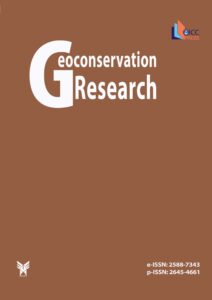Geotourism and Cultural Heritage
Authors
-
Kerran Olson
 1
1
-
Ross Dowling
*
 1
1
Abstract
Geotourism is often thought to refer solely to ‘geological tourism’, however, more recent views suggest that the term in fact refers much more broadly to encompass not only geology, but also fauna and flora as well as cultural aspects. An area’s geo-heritage can be defined as the geological base that, when combined with climate, has shaped the plants and animals of an area, which in turn determine an area’s culture; that is, how people have lived in that area both in the past as well as in the present. This link has rarely been explored in academic literature, so this paper aims to address the way in which geology has shaped Indigenous tourism in Australia. An example of the ways in which the link between geotourism and a place’s culture may be misunderstood is given through discussion of Uluru-Kata Tjuta National Park in central Australia, where tourists have climbed Uluru (Ayers Rock) for generations, despite protest from traditional land owners, the Anangu people. Evolving understandings relating to the importance of cultural authenticity in tourism have led to the climbing of Uluru being banned effective from 2019.
Read the full text of the articleKeywords
- Geotourism
- Australia
- Collaborative Approaches to Tourism
- Cultural Tourism
- Indigenous Tourism. Uluru-Kata Tjuta National Park
Main Subjects
References
2. Butler R & Hinch T (2007) Introduction: revisiting common ground. In R. Butler, & T. Hinch, Tourism and Indigenous peoples: issues and implications, pp. 2-12. Oxford: Butterworth-Heinemann.
3. Buultjens J & Fuller D (2007) Striving for sustainability: Case studies in Indigenous tourism. Lismore: Southern Cross University Press.
York: Oxford University Press.
5. Centre for Sustainable Destinations. (2010) Mission Programs: About Geotourism. National Geographic.
6. Dowling R.K (1996) Ecotourism and conservation management. Ranger, A Journal for Conservation Managers. 34: 26-28.
7. Dowling R.K (2011) Geotourism’s global growth. Geoheritage. 3: 1-13.
8. Dowling R.K (2013) Global geotourism – An emerging form of sustainable tourism. Czech Journal of Tourism. 2(2): 59-79.
9. Dowling R.K (2015) Geotourism. In: C. Cater, B. Garrod and T. Low(Eds.), The Encyclopedia of Sustainable Tourism, pp 231-232. Oxford: CABI.
10. Dowling R.K & Newsome D (Eds.), (In Press, A) Handbook of geotourism. Cheltenham: Edward Elgar Publishers.
11. Dowling R.K & Newsome D (In Press, B) Geotourism: Definition, characteristics and international perspectives. In: R.K Dowling & D. Newsome (Eds.), Handbook of geotourism. Cheltenham: Edward Elgar Publishers.
12. Dowling R.K & Pforr C (2017) Geotourismus in Australien und Neuseeland. In: C. Pforr & D. Reiser (Eds.), Tourismus in Australien und Neuseeland, pp 206-223. Berlin: De Gruyter, Oldenbourg.
13. Dudley N, Higgins-Zogib L & Mansourian S (2009) The links between protected areas, Faiths, and Sacred Natural Sites. Conservation Biology. 23(3): 568–577.
14. European Geoparks Network. (2017, May 9) What is a geopark. Retrieved from European Geoparks: http://www.europeangeoparks. org/?page_id=165
15. Gordon J (2012) Rediscovering a sense of wonder: Geoheritage,geotourism and cultural landscape experiences. Geoheritage. 4(1): 65-77.
16. Robinson A.M (2015) Geotourism, Geoparks and Geotrails: A tourism development opportunity for Australia. Bowen Hills: Ecotourism Australia.
17. Joyce B (2010) Australia's geological heritage: a national inventory for future geoparks and geotourism. In D. Newsome, & R. Dowling (Eds.), Geotourism: The tourism of geology and landscape (pp. 27-45).
Oxford: Goodfellow Publishers.
18. Kiernan K (2015) Landforms as sacred places: Implications for geodiversity and geoheritage. Geoheritage. 7(2): 177-193.
19. Lee E (2016) Protected areas, country and value: The nature–culture tyranny of the IUCN's protected area guidelines for Indigenous Australians. Antipode. 48(2): 355–374.
20. National Geographic (2007) Mission Programs: The geotourism charter. Washington: National Geographic.
21.National Geographic (2018) Geotourism. National Geographic: http://www.nationalgeographic.com/maps/geotourism/. Retrieved March 15, 2018.
22. Newsome D, Moore S & Dowling R. (2013) Natural Area Tourism: Ecology, impacts and management (2nd ed.). Bristol: Channel View Publications.
23. Norrish L, Sanders D & Dowling R (2013) Geotourism productdevelopment and stakeholder perceptions: a case study of a proposed geotrail in Perth, Western Australia. Journal of Ecotourism. 13(1): 52-63.
24. Rose D.B (1996) Nourishing terrains: Australian Aboriginal views of landscape and wilderness. Canberra: Australian Heritage Commission.
25. Ruhanen L & Whitford M (2014) Indigenous tourism and events for community development in Australia. In E. F. Sola, Tourism as an instrument for development : a theoretical and practical study (pp. 183-
194). Bingley, UK: Emerald.
26. Schmiechen J, & Boyle A (2007) Aboriginal tourism research in Australia. In R. Butler & T. Hinch, Tourism and indigenous peoples: Issues and implications (pp. 59-70). Oxford: Butterworth-Heinemann.
27. Shibish L.A, Dowling R.K & Willson G (2017) Aboriginal tourism in Western Australia: A case study of Yawuru Nagulagun Roebuck Bay Marine Park. In M. Whitford, L. Ruhanen & A. Carr (Eds.), Indigenous Tourism: Cases from Australia and New Zealand, pp.45-66. Oxford: Goodfellow Publishers.
28. Stokes A, Cook S & Drew D (2003) Geotourism: The new trend in travel. USA: Travel Industry. Association of America with National Geographic.
29. Taçon P (2014, October 17) Australian rock art is threatened by a lack of conservation. The Conversation. Retrieved May 18, 2017, from http://theconversation.com/australian-rock-art-is-threatened-by-alack-of-conservation-32900.
30. Tourism Research Australia (2018) International Visitors in Australia: Year Ending December 2017. Canberra: Tourism Research Australia, www.tra.gov.au.
31. Waitt G, Figueroa R. & McGee L (2007) Fissures in the rock: rethinking pride and shame in the moral terrains of Ulur. Transactions of the Institute of British Geographers, 32(2): 1475-5661.
32. Walker K & Moscardo G (2016) Moving beyond sense of place to care of place: the role of Indigenous values and interpretation in promoting transformative change in tourists' place images and personal values. Journal of Sustainable Tourism, 24(8): 1243-1261.
33. Whitford M, Ruhanen L & Carr A. (Eds.) (2017) Indigenous Tourism: Cases from Australia and New Zealand. Oxford: Goodfellow Publishers.



